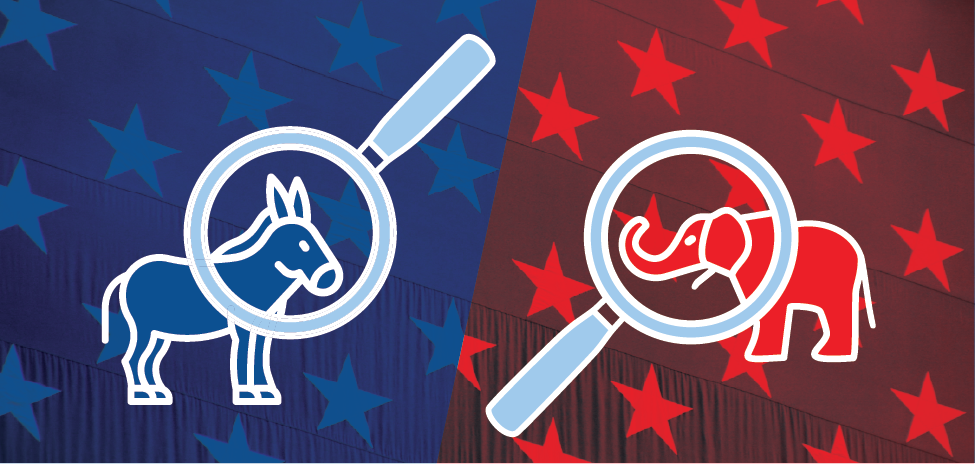
Education leaders—like the rest of us—have been inundated with news about the 2024 election, but it is still somehow hard to get a clear sense of how the election will impact policy. We hear from education leaders that they’re nervous about the election, but don’t yet know enough. Anxiety seems to be outpacing understanding.
To address this knowledge gap, Education First is publishing a comprehensive analysis designed to help education leaders understand and prepare for the election.
Click here to view the full analysis.
Here are a few of the major takeaways from our analysis:
As of this writing, the federal election landscape is hard to predict. The presidential election and control of the House is a toss-up. Senate control is leaning Republican, but neither party is likely to get a filibuster-proof majority.
This means the most likely outcome of the election is a divided government. In this scenario, a President Harris or Trump would face at least one chamber of Congress opposed to his or her policies. Education policymaking would therefore be limited to executive actions or bipartisan legislation.
However, there is still a significant possibility of Republicans winning unified control of the White House and both chambers of Congress. This means education organizations need to take Republican education policy proposals seriously. (Democrats may also win unified control, but the current Senate map makes this less likely.)
All told, there is a high level of electoral uncertainty this year. As uncomfortable as it feels, it is far better for education leaders to humbly recognize this election’s unpredictability (that is, understand its outcome is a “known unknown”) than to repeat the overconfidence many Democrats felt before the 2016 election (for whom the election’s outcome was an “unknown unknown”).
While this uncertainty may be uncomfortable, it is also helpful. Overconfidence can lead to dangerous complacency; nervousness can be channeled into action. Education organizations should begin preparing for all election outcomes now.
Harris has a fairly thin education policy platform so far, and we do not expect to hear new education policies from her before election day. The Harris campaign website has a single paragraph on education policy. The official Democratic National Committee (DNC) platform, while more detailed, was drafted for Biden’s candidacy, not hers. (As a sign of how rushed the transfer of the DNC platform to her campaign was, the document still includes a few stray references to “Biden’s second term.”)
If Harris wins, we can expect bipartisan legislation on career pathways and executive actions supporting pre-K, student loan repayment and civil rights protections for LGBTQIA+ students and students of color.
Overall, maybe the typos in the DNC platform were on to something: from an education perspective, a Harris administration might feel like “Biden’s second term.”
Project 2025 has garnered a lot of media attention—and rightfully so. It is by far the most detailed policy document published this cycle, and its proposals for the American education system are notably conservative, even among Republicans. Trump has distanced himself from Project 2025, and instead promoted his official policy platform, Agenda 47, which was formally ratified by the Republican National Committee (RNC).
While Agenda 47 is far less detailed than Project 2025’s—Agenda 47 is less than 1/50th of Project 2025 length—both documents propose remarkably similar policies. However, some of their most eye-grabbing proposals, like eliminating the U.S. Department of Education or influencing school curricula to reduce “indoctrination,” are also the least likely: they would face nearly insurmountable barriers in both Congress and in any attempts at implementation.
Rather, a potential second Trump Administration would be far more likely to advance partisan policies that could be implemented through executive order. This would likely begin by reversing the executive actions Biden has taken over the past two years of divided government, including Biden’s expansion of student loan forgiveness and protections for LGBTQIA+ students.
Education policy used to be fairly bipartisan; George W. Bush and Barack Obama, for example, had relatively similar ideas about education.
Those bipartisan days are gone—with one striking exception: career pathways. This term generally refers to efforts that help better align K12 education to high-paying jobs, such as through career and technical education (CTE), apprenticeships, work-based learning and school counseling.
Career pathways is one of the only policy areas which would advance regardless of the election’s outcome. Both Harris and Trump have promised to expand career pathways if elected, and have supported such programs in the past: in 2018, while Harris was a senator, Congress unanimously passed a major career education bill, which then-President Trump signed into law.
While federal elections tend to get the most attention, education leaders will probably feel the effects of state and local races more. Education policy is most directly set by governors, state legislatures, state education commissioners and ballot initiatives. For a case in point, look to how Florida’s education system has changed in recent years under Gov. Ron DeSantis’ unified Republican control.
By contrast, the U.S. Department of Education’s role in education policy-making is akin to a cafeteria lunch monitor: the monitor sets the ground rules, but your day-to-day experience is most impacted by the people at your table. If you share a table with bullies, the lunch monitor’s presence or retreat will matter more.
This cycle, there are a few key state races to watch. New Hampshire has the only toss-up governor’s race in the country and may also see control of its state legislature flip. Arizona is the only state to have both chambers of its state legislature rated as toss-ups. North Carolina is holding an election for its top education official, and a right-wing candidate defeated the incumbent moderate Republican in the primary. Ballot initiatives in Florida would make school board elections partisan and one in Nevada would put the state legislature directly in control of state universities.
After the Great Recession, banks started getting “stress tests.” These revealed how much banks were exposed to the rise and fall of certain assets and helped avoid another crash. Consider a similar approach for your own organization with the election. How much could the 2024 elections impact your organization?
Think about the risks to your organization upstream (your funding and resources), downstream (the people you serve) and internally (your organization’s culture).
Much like political candidates draft both a victory and a concession speech before the election, we recommend organizations go through the exercise of deeply considering what their plan will be if Democrats or Republicans win. We describe this process as creating a “Red Folder” and “Blue Folder” (and perhaps a “Purple Folder,” too).
A key part of your contingency plans should be deciding what your organization will do in the event of an unfavorable election result. We group the possible strategies into “playing offense” or “playing defense”; that is, fighting back or trying to hunker down. We recommend that philanthropies consider playing offense: forming funders collaboratives to fund advocacy, litigation and opposing initiatives. State and local education agencies will likely need to play defense.
Organizations should also see any governance changes as potential opportunities. For example, while expanding “parents’ rights” is typically seen as a way for conservative parents to fight against so-called “woke” curricula, it could just as easily be paired with community organizing to elevate voices from historically marginalized communities.
Regardless of the election outcome, Education First is here to help education leaders navigate this time of change. If you are looking for a thought partner, a high-level risk assessment or a contingency plan tailored to your organization, we’re here to help.
If you’d like to get in touch, please contact us.

